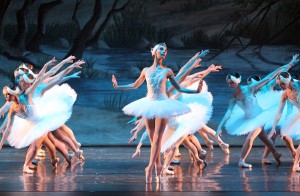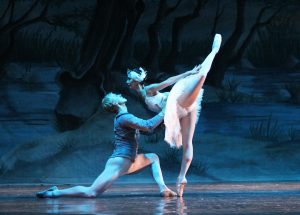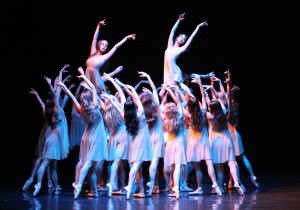Ana da Costa Ravishing in City Ballet of San Diego’s “Swan Lake”
 There are live dogs onstage in City Ballet of San Diego’s production of Act II of “Swan Lake,” and a live swan, as well – or, as close to a swan as a human dancer can be. Ana da Costa, a Brazilian ballerina new to the company this season, is a stunningly swanlike Odette, with a ridiculously mobile back, delicate but steely arms, and fingers that suggest dripping feathers. The production runs only this weekend, with shows at the Spreckels Theatre tonight at 8 and tomorrow at 2. If you love ballet, do not miss it. If you don’t think you love ballet, go – da C0sta will change your mind.
There are live dogs onstage in City Ballet of San Diego’s production of Act II of “Swan Lake,” and a live swan, as well – or, as close to a swan as a human dancer can be. Ana da Costa, a Brazilian ballerina new to the company this season, is a stunningly swanlike Odette, with a ridiculously mobile back, delicate but steely arms, and fingers that suggest dripping feathers. The production runs only this weekend, with shows at the Spreckels Theatre tonight at 8 and tomorrow at 2. If you love ballet, do not miss it. If you don’t think you love ballet, go – da C0sta will change your mind.
Da Costa’s breathtaking performance is the highlight, but this show offers multiple delights, particularly in “Swan Lake, Act II.” In this part of the classic ballet, Prince Siegfried, wandering in the forest, meets the beguiling Odette in human form. She’s the queen of a group of young women under an evil enchantment that, during the day, turns them into swans. Siegfried and Odette fall in love through meltingly romantic pas de deux.
 Trystan Loucado gives the best performance I’ve seen from him as Siegfried, supporting da Costa both in dramatic lifts and in his tender gaze. Loucado can look quirky, I think it it has to do with tilting his head and breaking his line, but here, the quirks were gone; he was truly a danseur noble. Act II also features Odette’s sister swans, and the corps was impeccable and lovely in the signature arabesque penchée (leaning forward with one leg in the air behind them). And the Little Swans, four dancers who interlock arms and can’t miss a beat, didn’t miss a beat.
Trystan Loucado gives the best performance I’ve seen from him as Siegfried, supporting da Costa both in dramatic lifts and in his tender gaze. Loucado can look quirky, I think it it has to do with tilting his head and breaking his line, but here, the quirks were gone; he was truly a danseur noble. Act II also features Odette’s sister swans, and the corps was impeccable and lovely in the signature arabesque penchée (leaning forward with one leg in the air behind them). And the Little Swans, four dancers who interlock arms and can’t miss a beat, didn’t miss a beat.
The music was performed live by the City Ballet Orchestra, and what a treat! Director John Nettles has developed this group over several years, and early on, I sometimes felt recorded music would have been preferable, but Nettles and his musicians have persevered, and the music was splendid.
The music was even more thrilling in “Requiem,” a premiere choreographed by Elizabeth Wistrich to Mozart’s Requiem. The orchestra was joined by the 100-voice San Diego Public Library Singers, who stood in the boxes on either side of the theater. Given the staging, I would have preferred having the parts mixed up; instead, the men plus soloists were on one side of the theater and the women on the other, and the blend suffered a bit. Still, it was rapturous to be surrounded by voices pleading “Ora pro Nobis,” pray for us.
 Initially, the choreography was as exciting as the music, with four men, bare chested and wearing filmy skirts, doing deep pliés, arms wide as if opening their hearts. Erica Alvarado made a stunning entrance, being lifted by the group as she held her lithe body in a swan dive, back arched and legs high. What looked like a sculptural form at the back of the stage, a gold mushroom shape (or a highly stylized cross) turned out to be a sort of keyhole through which dancers entered and exited.
Initially, the choreography was as exciting as the music, with four men, bare chested and wearing filmy skirts, doing deep pliés, arms wide as if opening their hearts. Erica Alvarado made a stunning entrance, being lifted by the group as she held her lithe body in a swan dive, back arched and legs high. What looked like a sculptural form at the back of the stage, a gold mushroom shape (or a highly stylized cross) turned out to be a sort of keyhole through which dancers entered and exited.
Groups formed and danced in unison, then broke apart, then reformed. It happened quickly, but I think Alvarado was tossed from one man to another while holding an arabesque. At one point she simply stood center stage and quietly faced the audience as activity went on behind her. A group of men sat inside the keyhole, their chests bare and heads down, like swimmers on a bench, or monks at prayer. A bent-armed position made me think of holding the book of life. The costumes, designed by Chelsea Brown and Tamlin Henahan, kept surprising: sometimes an ethereal blue, sometimes dark, filmy white dresses with hoods that looked nun-like.
It all felt utterly organic, as if Wistrich were tuning into the pulse of the group … and of the universe. And then it didn’t. In a series of sections with two couples – Alvarado with Stephano Candreva, and Ariana Samuelsson with Geoff Gonzalez – jazzy moves crept in and felt wrong for the music. A solo for Loucado seemed to lose energy. At one bizarre point, a Mozart figure – bewigged, in a frock coat with lace at the throat and cuffs – stood on a platform as if conducting.
The Requiem is a big piece of music, and I wondered if, partway through, Wistrich just ran out of time. I hope she does more with this rich and profound, if not completely realized, dance.
(All photos by Chelsea Penyak.)

Award-winning dance journalist Janice Steinberg has published more than 400 articles in the San Diego Union-Tribune, Dance Magazine, the Los Angeles Times, and elsewhere. She was a 2004 New York Times-National Endowment for the Arts fellow at the Institute for Dance Criticism and has taught dance criticism at San Diego State University. She is also a novelist, author of The Tin Horse (Random House, 2013). For why she’s passionate about dance, see this article on her web site, The Tin Horse
